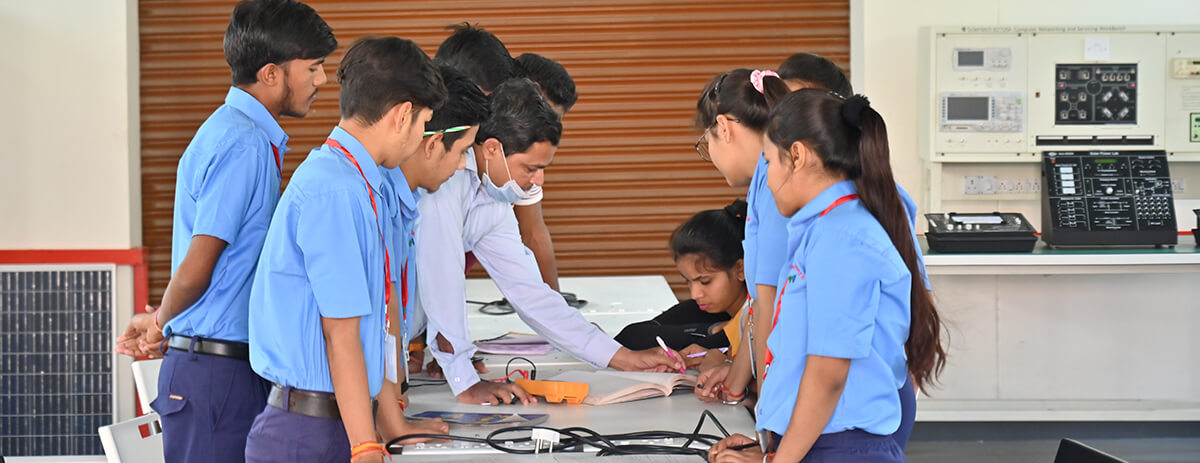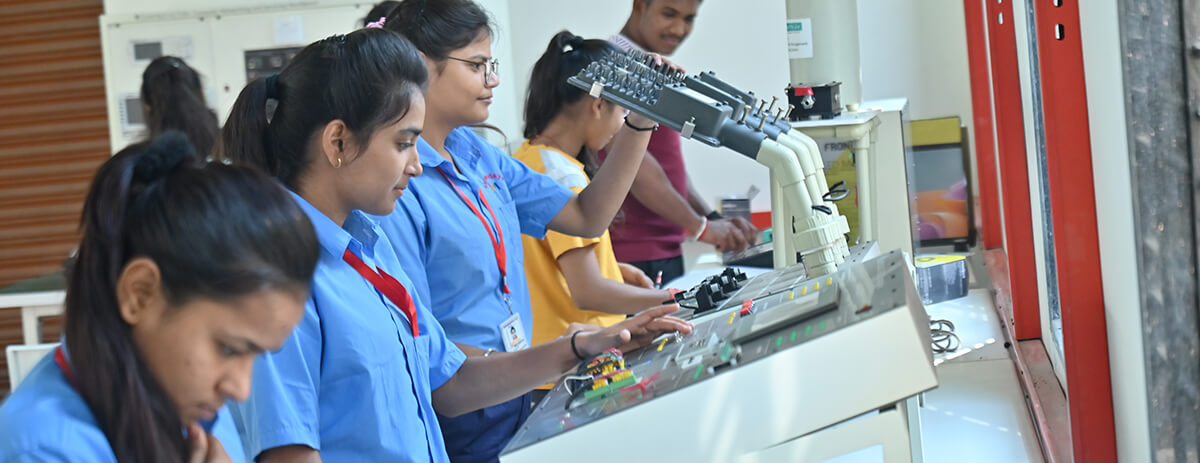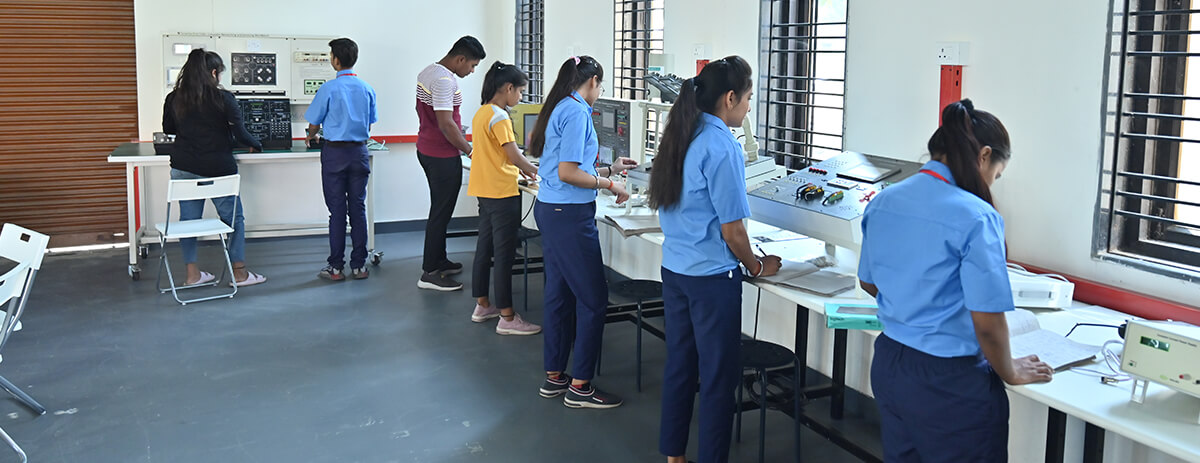IoT TECHNICIAN (SMART CITY): GENERAL INFORMATION
Click to see more images| Name of the Trade | I IoT TECHNICIAN (SMART CITY) (Non-Engineering Trade) |
|---|---|
| Trade Code | DGT/2007 |
| NCO - 2015 | - |
| NOS Covered | ELE/N9401, ELE/N7001, ELE/N7812, ELE/N5804, ELE/N7812, SSC/N9408, ELE/N1201, SSC/N9444, SSC/N9445, SSC/N9462, SSC/N9446, SSC/N9463, SSC/N9447, SSC/N9448, SSC/N9449, SSC/N8239, SSC/N9451, SSC/N9452, SSC/N9464, SSC/N9465, SSC/N9466, SSC/N9467, SSC/N9468 |
| NSQF Level | Level – 3 |
| Duration of Craftsmen Training | One year (1200 hours + 150 hours OJT/Group Project) |
| Entry Qualification | Passed 10th class examination with Science and Mathematics or with vocational subject in same sector or its equivalent. |
| Minimum Age | 14 years as on first day of academic session. |
During the one-year duration of IoT Technician (Smart City) trade a candidate is trained on professional skill, professional knowledge and Employability skillrelated to job role. In addition to this a candidate is entrusted to undertake project work and extracurricular activities to build up confidence. The broad components covered under Professional skill subject are as below:-
IoT TECHNICIAN (SMART CITY): Year wise Trade Overview
The trainee will select and perform electrical/ electronic measurement of meters and instruments. They will test various electronic components using proper measuring instruments and compare the data using standard parameter. The trainees will be able to Identify, place, solder and de-solder and test different SMD discrete components and ICs package with due care and following safety norms using proper tools/setup. They will construct, test and verify the input/ output characteristics of various analog circuits. They will also assemble simple electronic power supply circuit and test for functioning and test and troubleshoot various digital circuits. They will install, configure, interconnect given computer system(s) and networking to demonstrate & utilize application packages for different applications. They will develop troubleshooting skills in various standard electronic circuits using electronic simulation software. Trainees will apply the principle of sensors and transducers for various IoT applications. They can explore the need of different signal conditioning and converter circuits. They will also identify, test and troubleshoot the various families of Microcontroller. Trainees will plan and interface input and output devices to evaluate performance with Microcontroller.The trainee will identify different IoT Applications with IoT architecture.
The trainees will identify and test various parts of embedded system. They will be able to identify, test and Interconnect components/parts of IOT system. They will learn to identify and select various types of sensors used in Smart City. They will be able to position the appropriate sensors and collect the information required in Smart City. They will identify and select different wireless communication modules and topology to generate and record the data. They will learn to identify and test wireless network component such as Bluetooth module /Wifi Module/GSM Module/GPS Module. The trainees will identify Solar Panel Basic Testing, Characteristics, Charge Controller Circuit. They will perform installation, configuration and check working of IOT devices, network, database, app and web services. They will learn to monitor environmental parameters like Temperature, Humidity, Air Quality, PM2.5, PM10, CO2 etc. They will identify, test and troubleshoot different circuits of Smart street lighting system and its components. They will explore and troubleshoot different circuits used in SMART Parking. They will be able to troubleshoot different circuits used in SMART Traffic. They will learn to apply IoT Application for Water & Waste Management.
GENERAL
The Directorate General of Training (DGT) under Ministry of Skill Development & Entrepreneurship offers a range of vocational training courses catering to the need of different sectors of economy/ Labour market. The vocational training programmes are delivered under the aegis of Directorate General of Training (DGT). Craftsman Training Scheme (CTS) with variantsand Apprenticeship Training Scheme (ATS) are two pioneer schemes of DGT for strengthening vocational training.
IoT Technician (Smart City) trade under CTS is one of the newly designedcourses. The CTS courses are delivered nationwide through network of ITIs. The course is of one-year duration. It mainly consists of Domain area and Core area. In the Domain area (Trade Theory & Practical) impart professional skills and knowledge, while Core area (Employability Skills) imparts requisite core skill, knowledge and life skills. After passing out the training program, the trainee is awarded National Trade Certificate (NTC) by DGT which is recognized worldwide.
Trainee broadly needs to demonstrate that they are able to:
- Read & interpret technical parameters/documentation, plan and organize work processes, identify necessary materials and tools;
- Perform tasks with due consideration to safety rules, accident prevention regulations and environmental protection stipulations;
- Apply professional knowledge, core skills & employability skills while performing the job, and repair & maintenance work.
- Document the technical parameters in tabulation sheet related to the task undertaken.
PROGRESSION PATHWAYS
- Can join industry as Technician and will progress further as Senior Technician, Supervisor and can rise up to the level of Manager.
- Can become Entrepreneur in the related field.
- Can join as a technician in different IoT application industries for repair, servicing and installation of IoT devices.
- Can join Apprenticeship programme in different types of industries leading to National Apprenticeship certificate (NAC).
- Can join Crafts Instructor Training Scheme (CITS) in the trade for becoming instructor in ITIs.
- Can join Advanced Diploma (Vocational) courses under DGT as applicable.
COURSE STRUCTURE
Table below depicts the distribution of training hours across various course elements during a period of one year:
| S No. | Course Element | Notional Training Hours |
|---|---|---|
| 1 | Professional Skill (Trade Practical) | 840 |
| 2 | Professional Knowledge (Trade Theory) | 240 |
| 5 | Employability Skills | 120 |
| Total | 1200 |
Every year 150 hours of mandatory OJT (On the Job Training) at nearby industry, wherever not available then group project is mandatory.
| 4 | On the Job Training (OJT)/ Group Project | 150 |
|---|
Trainees of one-year or two-year trade can also opt for optional courses ofup to 240 hours in each year for 10th/ 12th class certificate along with ITI certification, or, add on short term courses.
LEARNING OUTCOMES
- Select electrical/ electronic measurement by selecting of single range with following safety precautions. (NOS: ELE/N9401)
- Test various electronic components using proper measuring instruments and compare the data using standard parameter. (NOS: ELE/N7001)
- Identify, place, solder and de-solder and test different SMD discrete components and ICs package with due care and following safety norms using proper tools/setup. (NOS: ELE/N7812)
- Construct, test and verify the input/ output characteristics of various analog circuits. (NOS: ELE/N5804)
- Assemble, test and troubleshoot various digital circuits. (NOS: ELE/N7812)
- Install, configure, interconnect given computer system(s) and networking to demonstrate & utilize application packages for different applications. (NOS: SSC/N9408)
- Develop troubleshooting skills in various standard electronic circuits using Electronic simulation software. (NOS: ELE/N1201)
- Apply the principle of sensors and transducers for various IoT applications. (NOS: SSC/N9444)
- Identify, select and test different signal conditioning and converter circuits. Check the specifications, connections, configuration and measurement of various types of sensor inputs as well as control outputs. (NOS: SSC/N9444)
- Identify, Test and troubleshoot the various families of Microcontroller. (NOS: SSC/N9445)
- Plan and Interface input and output devices to evaluate performance with Microcontroller. (NOS: SSC/N9445)
- Identify different IoT Applications with IoT architecture. (NOS: SSC/N9462)
- Identify, test and interconnect components/parts of IoT system. (NOS: SSC/N9446)
- Identify and test various parts of embedded system. (NOS: SSC/N9463)
- Identify and select various types of sensors used in Smart City. (NOS: SSC/N9447)
- Position the appropriate sensors and collect the information required in Smart City. (NOS: SSC/N9447)
- Identify and test Wired & Wireless communication medium such as RS232, RS485, Ethernet, Fiber Optic, Wi-Fi, GSM, GPRS, RF etc. and Communication protocol. (NOS: SSC/N9448)
- Identify Solar Panel Basic Testing, Characteristics, Charge Controller Circuit. (NOS: SSC/N9449)
- Perform installation, configuration and check working of IOT devices, network, database, app and web services. Monitor environmental parameters like Temperature, Humidity, Air Quality, PM2.5, PM10, CO2 etc. (NOS: SSC/N8239)
- Establish and troubleshoot IoT connectivity of devices to cloud having multiple communication medium, protocols, device management and monitoring. (NOS: SSC/N9451)
- Demonstrate and Deploy responsive Web Application using APIs and generate reports using templates. (NOS: SSC/N9452)
- Identify and test Smart Lighting system and its components. (NOS: SSC/N9464)
- Identify, select, install and troubleshoot different module / devices used in SMART Street Light based on IoT and Cloud Technology. (NOS: SSC/N9465)
- Identify, select, install and troubleshoot different module / devices used in SMART Parking. (NOS: SSC/N9466)
- Identify, select, install and troubleshoot different module / devices used in SMART Traffic. (NOS: SSC/N9467)
- Apply IoT Application for Water & Waste Management. (NOS: SSC/N9468)


